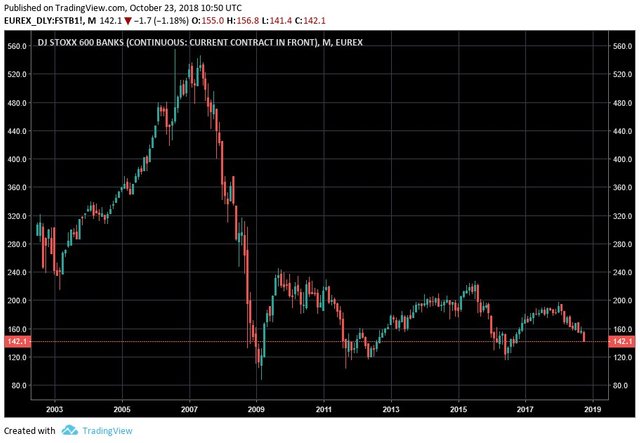Tales From The Crypt: Blood On The Streets Of Europe?

The nightmare of other financial crisis is threatening Europe in this days, this time, from Italy. Back in October 2008, in Central Europe, economists and many more people were wondering which bank will become bankrupt first. It was a great fortune no bank run broke out, if it occurred, the crisis of 2008-2009 would have been much more extended. Because:
As a bank run progresses, it generates its own momentum: as more people withdraw cash, the likelihood of default increases, triggering further withdrawals. This can destabilize the bank to the point where it runs out of cash and thus faces sudden bankruptcy. Wikipedia
Banks are vulnerable
But without banks, which are blamed often by some extreme politicians and also some men in the street for the crisis, debt or other miserable conditions, modern economies can’t operate. (At least, not yet. Maybe in a distant future if cryptocurrencies take over.)
All banks are extraordinarily vulnerable to economic crisis because they are operating with high leverage: they are lending much more than the value of total deposits they have. If only one part of the debtors declares bankruptcy, banks are losing all their own capital. For similar reasons, in the investment world, leverage (investing from debt) is considered extremely dangerous.
Are we in crisis now?
That’s the reason why bank shares are falling first if economic growth stalls, and mostly they are falling more than shares of other industries. And that can be one of the reasons why European banks never really recovered from the crisis of 2008-2009.
Or, should we say, the crisis of 2008-2019, or crisis of 2008-2029? Has Europe recovered from the crisis? Maybe not, or some countries yes, some not. See this minor synthesis of the European (EU) crises (mostly from Wikipedia):
- Ireland 2008-2009
- Portugal 2010-2014
- Spain 2008-2014
- Greece 2009-????
- Cyprus 2012-2013
- Italy 2018-????
- Eurozone debt crisis: 2010-2012 (Or, 2008-???? ?)
Canaries in the coal mine
There are so many question marks, and I can’t solve this puzzles. But I’m interested in the first line in the stock market. So, what are doing shares of banks, operating in the economy like canary birds in the coal mine? Premature warning indicators.
We need an index containing the dividends because banks are paying often, if not in trouble, a nice amount. (About problems with different index types I wrote here yesterday.) By the Stoxx index family, for example, the bank’s price return index (SX7E, dividends excluded) fell 70.9 percent since January 2001 (from 335 to 97 points). The total return or gross return index, dividends included, fell only 43.6 percent (from 105 to 59 approximately). The NR (net return, with dividends after taxes) index fell 51.1 percent.
Three nice bottoms
On the second chart – showing the price of a futures contract – we can see that the bank shares in Europe haven’t recovered much from the 2008-2009 lows. This index sunk to 120 in three periods: in 2008–2009 (crisis), in 2011-2012 (Eurozone crisis) and 2016 (Brexit-vote). But after that cases, in 2009-2010 and 2012-2015, the indicator doubled, and in 2016-2017, it surged 50-60 percent.
Top 10 Components of Euro Stoxx Banks Index
(Source: Fact Sheet of September 30.)
- Banco Santander (15.43%)
- BNP Paribas (13.40%)
- ING Group Bank (9.60%)
- Banco Bilbao Vizcaya Argentaria (8.07%)
- Intesa Sanpaolo (7.92%)
- Group Societe Generale (6.59%)
- Unicredit Bank (6.06%)
- Deutsche Bank (4.14%)
- KBC Group (3.71%)
- Credit Agricole (3.40%)
Why is it interesting now? Is it time to buy? Maybe, soon, but not yet. If the Italian crisis deteriorates, when the above index falls below 120 or 100 again, if panic-like news is streaming from the internet… Like: “creditors are accepting losses on their bond’s values”, “Italian bailout program”, “avoid capital controls”, “preventing a collapse of the banking sector”, “possible exit from the Eurozone”…
Too big to bail?
So, when there’s blood on the streets again. In this case, I would buy European banks. But it is still extremely dangerous because Italy has not only a very high debt level, it is also a large and populous country. If the United Kingdom really leaves the EU, it will be extremely tough bail this country out. And their politicians are showing little cooperation willingness today.
Motto:
Bottoms in the investment world don’t end with four-year lows; they end with 10- or 15-year lows. Jim Rogers in Investopedia
Other posts in this series:
- Is This Indicator Really Predicting A Huge Rally? – Gold, Silver, Mines
- Black Sugar, Baby, And Hot Money – Sugar and Coffee
- And The Very Best Stock Market In The World Was…
- Tales From The Crypt – Greek Blood On The Streets
- Deadly Coffee, With Cocoa Flavour
- 8 Reasons Why Gold Mines Can Rally Again
- Buying At Prices Of 2009? – Turkey
- The Curse Of The Disaster – Uranium mining
Disclaimer:
I am not a financial advisor and this content in this article is not a financial or investment advice. It is for informative purposes only, or simply to make you think, entertain, increase testosterone and adrenaline level. Consult your advisers before making any decision.
Info:
You can message me in Discord.
(Cover photo: Pixabay.com)


You got a 95.85% upvote from @bdvoter courtesy of @deathcross!
Delegate your SP to us at @bdvoter and earn daily 100% profit share for your delegation & rewards will be distributed automatically daily.
500 SP, 1000 SP, 2500 SP, 5000 SP, 10000 SP.
If you are from Bangladesh and looking for community support, Join BDCommunity Discord Server & If you want to support our service, please set your witness proxy to BDCommunity.
Hi dear sir your article is right for cryptocurrency for long term bet.in short term cryptocurrency is down but long term best investment in cryptocurrency
You got a 34.19% upvote from @oceanwhale courtesy of @deathcross! Earn 100% earning payout by delegating SP to @oceanwhale. Visit www.OceanWhaleBot.com for details!
You got a 13.49% upvote from @brupvoter courtesy of @deathcross!
You got a 2.14% upvote from @minnowvotes courtesy of @deathcross!